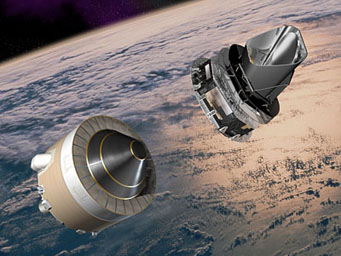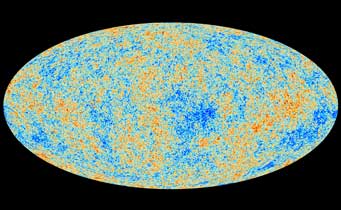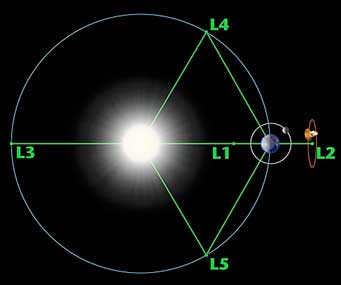But don't pull out the tissues — this end is a happy one.
The Planck mission has ended. On October 23rd (which incidentally would have been my grandma’s 100th birthday), ESA’s microwave-perusing spacecraft shut down forever.

In 2009 Planck separated from the launcher a couple of minutes after its fraternal twin, Herschel. The two spacecraft then independently headed to the second Lagrangian point (L2), some 1.5 million km from Earth in the direction opposite to the Sun. The Planck spacecraft has now shut down after four years of phenomenal work.
ESA / D. Ducros
This isn’t a woeful tale of fizzled-out funding or failed flywheels: Planck has reached its natural end after an electronic life well lived. The spacecraft produced exquisite maps of the temperature blotches in the cosmic microwave background (CMB), the ancient radiation permeating space that is our earliest view of the infant universe. It also revealed a great deal about vistas closer to home; among these achievements is cementing the existence of the long-debated, gargantuan bubbles ballooning from the Milky Way’s core.
Planck’s CMB map upheld to glorious precision the simple cosmological model that describes the universe using only six numbers. According to its first 15.5 months of observations, the universe is 13.798 billion years old, dark energy makes up 69.2% of the universe’s mass-energy content, and the universe’s current expansion rate — described by the Hubble constant, the ratio of a galaxy’s recession velocity, or redshift, to its distance — is 67.80 km/s per megaparsec. This Hubble value is significantly lower than that calculated from supernovae (73.8 km/s per Mpc). The discrepancy has intrigued astronomers, but as of yet there’s no solution.

The oldest light in our universe, the cosmic microwave background suffuses the cosmos. This map created from all nine frequency bands of the Planck spacecraft shows the CMB's details at a precision never before acquired.
ESA and the Planck Collaboration
Planck launched May 14, 2009 with the infrared Herschel Space Observatory, which also shut down earlier this year. It observed at an angular resolution roughly twice as fine as that of its predecessor, WMAP, and refined that mission’s cosmology results. The spacecraft’s High and Low Frequency Instruments worked together to finish five full-sky surveys before the HFI ran out of coolant on January 14, 2012 — within a week of its predicted end, notes project scientist Charles Lawrence (JPL).
Originally slated to run for 15 months, Planck received two extensions thanks to its flawless performance, continuing to observe with LFI until the mission team started shutting everything down a couple of weeks ago. While LFI’s hydrogen-absorption cooler might have kept working a wee longer, the extra bit of data wouldn’t have helped researchers enough to justify another extension, Lawrence says. As it is, the team received two “bonus” months: officially the mission should have ended in August, but the orbital mechanics guys picked October as the best to push the craft from the L2 Lagrangian point, the gravitational balancing point on the opposite side of Earth from the Sun.

This diagram (which is not to scale) shows the Lagrangian points associated with the Sun-Earth system. Lagrangian points are positions in space where the gravitational forces of the two-body (Sun-Earth) system produce regions of semi-equilibrium. Spacecraft stationed here need to consume less fuel to maintain position. Many spacecraft are sent to L2, the Lagrangian point on the opposite side of Earth from the Sun.
NASA / WMAP Science Team
Although we often talk about Lagrangian points as stable places in the Earth-Sun gravitational sandbox, they’re only semi-stable. Space at L2 is shaped like a saddle, with one stirrup side pointing right at Earth and the other directly away. A spacecraft can move forward and backward in the saddle and not fall out, but if it moves sideways too much (that is, directly toward or away from Earth), it’ll slide out. If it slides out on the Earth-facing side, it’ll head toward the planet — and we don’t really need a rogue spacecraft drifting toward us. Engineers therefore fire the thrusters just enough to push defunct missions out the saddle’s far side, sending them into an Earth-trailing orbit that will bring them back to Earth’s vicinity in about 300 years.
Despite the craft’s demise, there’s a bevy of beautiful data to explore. All told, the team has 29 months of HFI data and 50 months of LFI data in hand, data that Lawrence raves are “fantastic.” The researchers plan to release the next set of observations in mid-2014, including some of the long-anticipated polarization data. These data will not include what are called primordial B-modes, the spiral-like polarization fingerprint left behind by the theoretical epoch of inflation, which ostensibly happened about 10 nano-nano-nano-nanosecond after the Big Bang. The polarization data are a beast to analyze, so the team doesn’t expect to release anything related to B-modes until at least 2015. The 2014 release will deal with another pattern called E-modes, which reveal information about the density fluctuations that gave rise to the CMB’s mottled look.
In the end, Lawrence sums Planck up in three words: “A brilliant success.”
 5
5









Comments
Justin S
October 23, 2013 at 8:20 am
What a refreshing story!
You must be logged in to post a comment.
Peter W
October 23, 2013 at 9:37 am
“Planck’s CMB map upheld to glorious precision the simple cosmological model that describes the universe using only six numbers.” That’s great, except at least seven numbers are required to describe the cosmos. Prior to 1998, the cosmological model was even simpler, and included only five numbers. But that five-parameter model failed to predict the accelerating expansion, and an enigmatic “sixth number,” dark energy, was added. The two “forgotten numbers,” energy coupling eta (0<1) and center-to-center spacing of galaxy clusters Ri (about 10^23 meters), have been completely overlooked by cosmologists. I do not know if these two numbers, eta and Ri, account for the mysterious dark energy, but I do know the model without them is causally incomplete. Simple can be too simple.
You must be logged in to post a comment.
Anthony Barreiro
October 24, 2013 at 3:15 pm
"[F]izzled-out funding or failed flywheels" -- that's easy for you to say!
You must be logged in to post a comment.
Allan Holmgren
October 28, 2013 at 10:15 pm
The discrepancy in the Hubble constant and calculated expansion via supernova could be the result of a temporal anomaly. When we observe a distant galaxy that is rushing away from us, it is the spacetime that the galaxy resides in that is receding at high velocity. In some cases the recession rate is almost approaching the speed of light. I think that at these high velocities the time component of that distant region is incrementing slower. If a given object is moving at a certain speed but less time is passing or passing slower, it would appear that the object is speeding up to an observer at a distance. If a man crosses a twenty foot room in four seconds we can calculate his speed. If he crosses that room and only two seconds have passed then we would say that his speed has increased.
You must be logged in to post a comment.
pat
October 30, 2013 at 8:09 pm
ISON there is hardly a thing on the subject@!!! And as for comets,... they are . , waiting silently, Then BANG the blow up and disturb their neighbors.Either in the asteroid belt or ort cloud. here comes the comets, asteroids, and
You must be logged in to post a comment.
You must be logged in to post a comment.